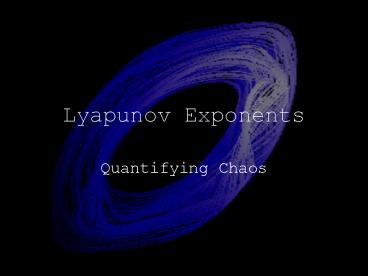Lyapunov Exponents - PowerPoint PPT Presentation
1 / 11
Title:
Lyapunov Exponents
Description:
Spectrum of exponents corresponding to number of variables, ... Barker, G.L, and Gollub, J.P. Chaotic Dynamics an introduction Cambridge University Press, 1996. ... – PowerPoint PPT presentation
Number of Views:391
Avg rating:3.0/5.0
Title: Lyapunov Exponents
1
Lyapunov Exponents
- Quantifying Chaos
2
Lyapunov Exponent Defined
- Average divergence between neighboring
trajectories in an attractor - Spectrum of exponents corresponding to number of
variables, but most concerned with the dominant,
1st exponent - Can be ,-,0 depending on behavior
3
Attractors
- Trajectories converge toward attractors
- Simple, normal examples include points, limit
cycles, saddle points - Chaotic Attractors are strange with fractal
structure and non-integer dimension
4
Are these chaotic attractors?
- Poincare section movies
- Time-delay reconstructed attractors
5
Why Attractor Reconstruction
- Our position data is unbounded, so analyzing
nearby trajectories in regular phase space would
be unfeasible - Folded position data would have discontinuities
- The velocity time series doesnt have these
problems, and as a result is a good candidate for
analysis - This is the method employed by Wolfs programs
BASGEN and FET
6
Time Delay Attractor Reconstruction
- Thankfully, although a time-delay reconstructed
attractor is different than the actual underlying
attractor it has the same properties such as
Lyapunov exponents and dimension measure - Build an attractor from a time series of one
variable, angular velocity in our case - Two significant parameters, time delay (tau) and
embedding dimension
For example, given a time series of one variable
A time delay reconstruction for a given delay
time (t), and embedding dimension (d), would be
7
Time Delay (tau)
- A correlation function can help in choosing a
reasonable value
(Williams)
8
Embedding Dimension
- Idea of False Nearest Neighbors can help
determine adequate embedding dimension
(Kennel)
9
Wolfs Algorithm
- Average of individual locally calculated Lyapunov
exponents from time t0 to M - In this version, the length of time between
replacements is fixed
10
Conclusions
- Have acquired a better understanding of
appropriate parameter values, namely tau and the
embedding dimension, but the Lyapunov exponent
calculation is not as parameter independent as I
hoped - Would like to have a better feel for the strange
attractor and the validity of time-delay
reconstruction - Estimated the Dominant Lyapunov exponent for our
system to be 2 bits/sec
11
Sources
- The following materials were integral in
preparing this presentation - Barker, G.L, and Gollub, J.P. Chaotic Dynamics an
introduction Cambridge University Press, 1996. - R. Hegger, H. Kantz, and T. Schreiber, Practical
implementation of nonlinear time series methods
The TISEAN package, CHAOS 9, 413 (1999) - Available online http//www.mpipks-dresden.mpg.d
e/tisean/TISEAN_2.1/docs/indexf.html - Kennel, Matthew B., Brown, Reggie, Abarbanel,
Henry D.I., Determining embedding dimension for
phase-space reconstruction using a geometrical
construction Physical Review A, Vol 45, Num 6,
15 March 1992, 3403-3411. - Williams, Garnett P., Chaos Theory Tamed, Joseph
Henry Press, Washing D.C. 1997. - Wolf, Alan, Swift, Jack B., Swinny, Harry L.
Vastano, John A. Determining Lyapunov Exponents
from a Time Series, Physica 16D, (1985), 285-317.































